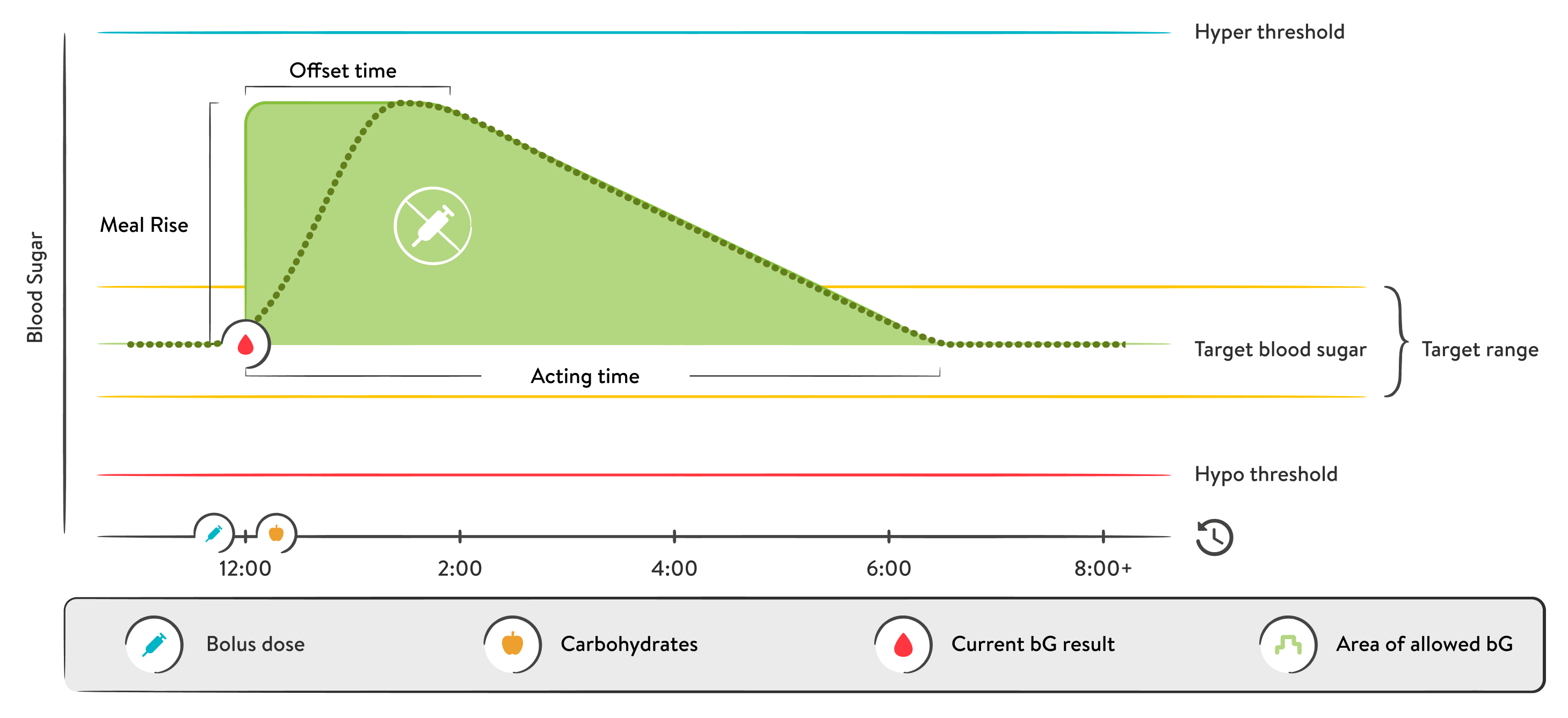What is meal rise?
After a meal, blood sugar levels usually increase by a noticeable amount, even in people without diabetes. Depending on the type of meal, your blood sugar level can reach a maximum about an hour after your meal and return to its original level after another one to two hours. This is a normal process and so the mySugr Bolus Calculator takes this into account using “meal rise”.

The dotted line shows how your blood sugar level might change after a carb bolus. The mySugr Bolus Calculator tolerates an increased blood sugar level within the “meal rise range” (green) without calculating an extra correction bolus. When you enter a carb amount the “meal rise” setting is added to the blood sugar target value. How long the meal rise lasts (the width of the green area) is determined by the “offset time” and the “acting time”.
The currently allowed blood sugar value considers the following factors:
- The upper limit of the “target range” for your current “time block”
- Blood sugar values that were tolerated as a “meal rise” and which have had a carb bolus that is still active (acting time)
- The expected reduction of your blood sugar level due to the effect of insulin during the “acting time” (the decrease between the end of “offset time” and end of “acting time”)
- Excursions beyond the “target value” that have had a correction bolus that is still active (acting time)
What is offset time?
The offset time is the time before the insulin begins to lower blood sugar levels. After the offset time, your blood sugar level should decrease because of the insulin, and at the end of the acting time it should return to the target level. The offset time must be at least 45 minutes, and the maximum value will be limited by the acting time that you choose. You and your healthcare provider should discuss what offset time is appropriate for you.
What is insulin correction factor?
The Insulin Correction Factor is used by the mySugr bolus calculator to calculate the amount of insulin that you need to correct high blood sugar values and bring you back to your target value.
Therefore, the bolus calculator needs to know how much 1 unit of insulin will lower your blood sugar. Again, you might have different factors at different times of the day, which you can set here as needed.
Remember, if you’re ever unsure, talk with your doctor. They can help you find a good place to start and do some fine-tuning. In fact, it’s easy to test your correction factor while testing your active insulin duration, as described above.
To do so, you’ll need to track how much a unit of insulin lowers your blood sugar level (Insulin Correction Factor), as well as how long it takes for that unit to stop working in your body (Active Insulin Duration).
As mentioned earlier, it’s smart to repeat this experiment a few times to get an accurate read of the situation. It’s also important to ensure that there’s no old insulin to interfere with the experiments. And again, for safety’s sake, check your results with your doctor.
What is carbs/insulin ratio?
The Carb to Insulin Ratio is used by the bolus calculator to calculate the amount of insulin that you need to inject for your meal. Therefore the bolus calculator needs to know the amount of carbs in your meal to provide you with an accurate insulin recommendation.
Set in your ways when it comes to thinking about your insulin at mealtimes? Does, “That’s a four unit sandwich,” and, “I’d need at least ten units for that meal,” sound familiar?
But we need to do the work from the opposite direction to uncover a piece of the equation.
If you’re counting carbs by grams, we need to know how much work a single unit of insulin can do. In other words, how many grams of carbs can you eat for one unit of insulin? If you’re counting carbs by exchanges, the mySugr Bolus Calculator will ask you how many units of insulin you take for one exchange.
For example, if you count 15 grams of carbs as one exchange (configured in the settings), and would inject one unit of insulin for that, then your carb to insulin ratio is 1.
If you don’t know your carbs to insulin ratio(s), start by talking with your doctor. They can help you find a good starting point, and you can do some testing to fine-tune the settings.
You might have different ratios at different times of the day, which you can set as needed.